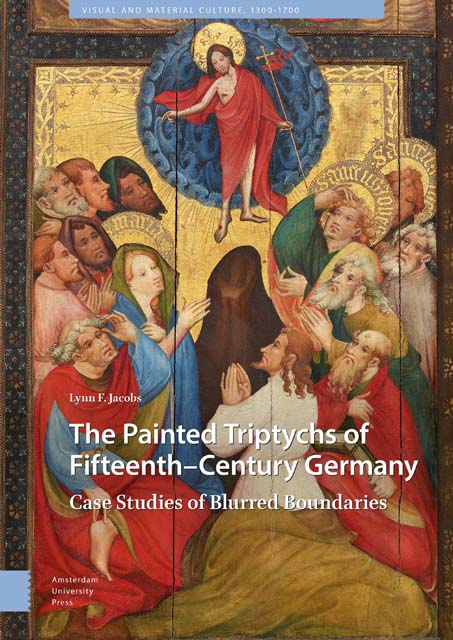Book contents
- Frontmatter
- Dedication
- Table of Contents
- List of Illustrations
- Acknowledgements
- Introduction
- 1 Framed Boundaries: Conrad von Soest and Early Fifteenth-Century Westphalian Triptychs
- 2 Transparent Boundaries: Colour on the Exterior of German Fifteenth-Century Triptychs
- 3 Regional Boundaries : Rogier van der Weyden’s Columba Altarpiece and Cross-Influences Between the Netherlands and Cologne
- 4 Spiritual Boundaries : The Master of the St. Bartholomew Altarpiece and the Border between Reality and Eternity
- 5 Coda: The Triptych in the Age of Dürer
- Bibliography
- Index
4 - Spiritual Boundaries : The Master of the St. Bartholomew Altarpiece and the Border between Reality and Eternity
Published online by Cambridge University Press: 16 November 2022
- Frontmatter
- Dedication
- Table of Contents
- List of Illustrations
- Acknowledgements
- Introduction
- 1 Framed Boundaries: Conrad von Soest and Early Fifteenth-Century Westphalian Triptychs
- 2 Transparent Boundaries: Colour on the Exterior of German Fifteenth-Century Triptychs
- 3 Regional Boundaries : Rogier van der Weyden’s Columba Altarpiece and Cross-Influences Between the Netherlands and Cologne
- 4 Spiritual Boundaries : The Master of the St. Bartholomew Altarpiece and the Border between Reality and Eternity
- 5 Coda: The Triptych in the Age of Dürer
- Bibliography
- Index
Summary
Abstract
This chapter investigates the Master of the St. Bartholomew Altarpiece as an artist who raises questions about regional boundaries both in terms of his origins and workshop location. In addition, his works engage with boundaries between religious intensity and humour, and with boundaries between sculpture (monochrome and polychrome) and painting. But the most critical boundary explored in the Bartholomew Master's triptychs is that between heaven and earth. In exploring this boundary, the Bartholomew Master manipulates space, at times creating spatial ambiguities, pushing figures out of the painting into real space, or giving the impression of recession into an infinity beyond. In so doing, he maps relations between the mundane, earthly realm and the eternal, transcendent one.
Keywords: Master of the St. Bartholomew Altarpiece, grisaille, humour, sculpted retables, Carthusians, wounds of Christ
In the Master of the St. Bartholomew Altarpiece's Mass of St. Gregory in Trier (Fig. 4.1), Pope Gregory is shown kneeling before an altar, raising his hands in the orans prayer gesture. The altar is located within the choir of a church, with the sanctity of its space emphasized by its enclosure: at the right, a door opens into the choir space, and the lintel at the top marks off the division of the holy choir from the less sacred space of the church behind. Moreover, the contrast between the large-scale cardinal (just behind the pope), who holds the pope's tiara, and the small-scale cardinal with the staff standing farther back outside the choir, reinforces the separation of spaces, thereby heightening the sacredness of the choir space in which the miracle is shown taking place. That miracle is the appearance of Christ, who emerges out of a black stone sarcophagus, which appears on top of the altar. Behind him float heads and objects that reference his Passion, the so-called arma Christi. Among them are: a head spitting at Christ, Judas with his money bag, Peter and the cock that crowed, the column of the Flagellation, the cross, Longinus's spear, etc. At the top, two angels cling to tendrils that link to form an arch, which surrounds the scene and suggests the tracery at the top of a carved shrine. At the right, these tendrils pass in front of the lintel of the door that leads into the choir space.
- Type
- Chapter
- Information
- The Painted Triptychs of Fifteenth-Century GermanyCase Studies of Blurred Boundaries, pp. 209 - 254Publisher: Amsterdam University PressPrint publication year: 2022



